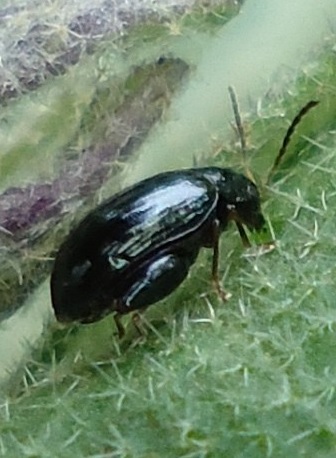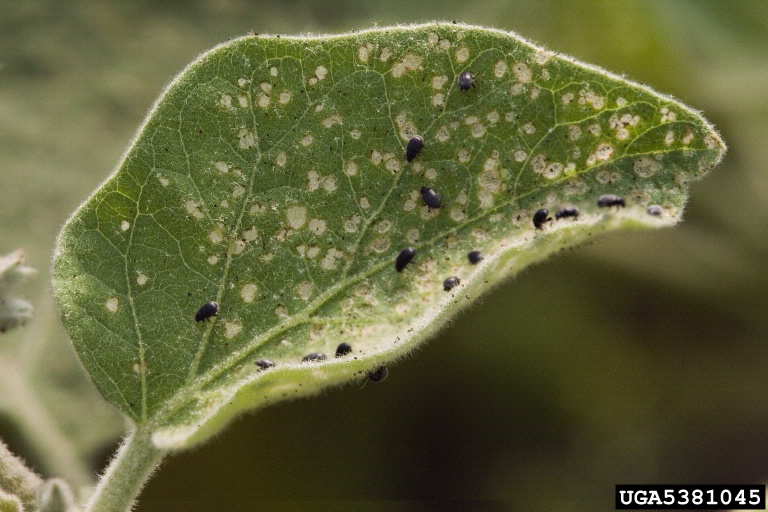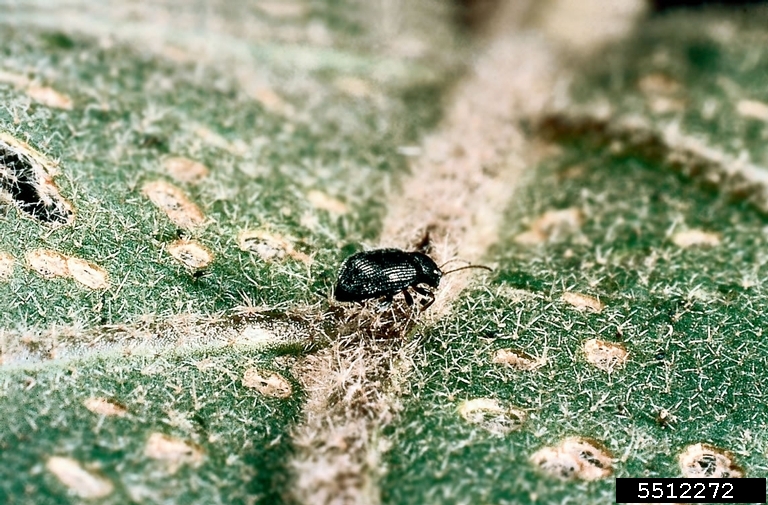 Flea Beetles in the Garden - June 7, 2017 Jeff Schalau, Agent, Agriculture & Natural Resources University of Arizona Cooperative Extension, Yavapai County Flea beetles are small insects, 1/8 inch long or shorter, which can be found on a variety of garden vegetable plants. In our area, they particularly impact young plants in the Solanaceae (peppers, tomatoes, potatoes, and eggplants) and cole crops (cabbage, broccoli, kale, arugula, etc.). They get their name from their well-developed hind legs and when disturbed they jump like fleas. Flea beetles can overwinter on weed hosts surrounding the field, on residues of previous crops, or in the soil if the previous crop was a flea beetle host. In small garden plots, this can make them a yearly problem. Flea beetles produce a characteristic injury known as "shot-holing”. The adults chew many small holes or pits in the leaves, which make them look as if they have been damaged by fine buckshot. As mentioned above, young plants and seedlings are particularly susceptible. Growth may be seriously retarded and plants even killed. Leaf feeding also damages plant appearance. In some cases, adults may feed directly on ripe fruits such as tomatoes (I have not observed this in my garden). Flea beetle larvae are very small grubs which live in the soil. The larvae can also feed on plant roots, but the damage is usually minimal except on potatoes. Monitor for flea beetles soon after transplanting or after plants emerge. Check newly emerged seedlings for flea beetle damage at least twice weekly until plants are well established. I also look carefully below my eggplant transplants to try and see hopping adult flea beetles. Once you learn to recognize the damage, it is somewhat unique and easily distinguishable from other pest damage. Relatively low flea beetle populations can cause noticeable damage when plants are in the cotyledon or first-leaf stages. Once plants have five leaves they can tolerate several beetles per plant without damage and older plants become increasingly tolerant. You should treat flea beetles when small holes show on seedlings or on new transplants. Damage thresholds for treating established plants are when 10-20% of the foliage is destroyed. Cultural controls and pyrethrin insecticides are the favored organic treatments. Pyrethrin insecticides are not effective for more than a day or so and repeat applications will probably be necessary. Cultural controls include crop rotation, high seeding rates (to provide lots of sacrificial plants which can be thinned to desired density), and use of transplants (rather than direct seeding). “Least toxic” repellents can also be used which include: diatomaceous earth, kaolin clay, and neem insecticide. Some growers manage flea beetles by using a trap crop. This is done by planting highly favored crop before you plant your main crop, in an effort to attract flea beetles away from the main crop. Radish is often used to trap cole crop feeders. Adult flea beetles will be attracted to the tallest, earliest crops available. Once beetles are actively feeding in the trap crop, they can be sprayed with an insecticide, or simply harvested. I’m not sure how effective this would be in our area given the relative abundance of London rocket and other weedy mustard relatives found in our area. Conventional insecticides can also be used on flea beetles. These include: carbaryl, permethrin, spinosad, and bifenthrin. Applications of these insecticides will be effective for about 7 to 10 days. For transplants, one insecticide treatment is usually all that is required. For seedlings, two applications may be needed. As with all pesticides, carefully read and follow all label directions. Pay particular attention to ensure that any flea beetle insecticides being considered are properly registered for use on the crop. Flea beetles are usually an early season pest and it is best to try and manage their populations prior to flowering. The insecticides recommended above can negatively impact bees and other beneficial insects (pollinators and predators). Application prior to flowering will minimize risk to beneficial insects. In my garden, I expect flea beetle damage on eggplant transplants each year. It sometimes occurs on peppers too, but they seem to outgrow the damage without pesticide applications. I usually apply carbaryl dust to the lower portion and soil beneath my eggplants and monitor for subsequent damage. I have also included some photos of flea beetles and management publications below. Follow the Backyard Gardener on Twitter – use the link on the BYG website. If you have other gardening questions, call the Master Gardener help line in the Camp Verde office at 928-554-8992 or e-mail us at verdevalleymg@gmail.com and be sure to include your name, address and phone number. Find past Backyard Gardener columns or provide feedback at the Backyard Gardener web site: http://cals.arizona.edu/yavapai/anr/hort/byg/. Photos  Closeup of eggplant flea beetles (Epitrix fuscula) and damamge to eggplant foliage (David Cappaert, Bugwood.org).  Closeup of eggplant flea beetle (Epitrix fuscula, Kansas Department of Agriculture , Bugwood.org). Additional Resources Flea Beetles on Vegetables Utah State University Extension digitalcommons.usu.edu/cgi/viewcontent.cgi?article=1902&context=extension_curall Flea Beetles in Home Gardens University of Minnesota Extension www.extension.umn.edu/garden/insects/find/flea-beetles/docs/M1210.pdf |